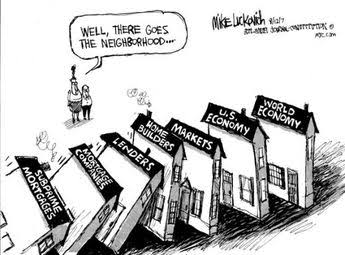In 2008, U.S. and many other countries propinquity to it faced a nastier depression known as the great depression. One of the reasons which turned that situation into a depression involves issuing housing loans to a large number of subprime borrowers (low-income group people who have high chances of defaulting) without backing a suffice security or low-quality security at low rates.
However, there is a limit to debt-fuelled consumption especially in big countries like united states, where there is a high demand for goods and services. An economy cannot be left to capitalism as government intervention and intervention with correct economic policies that facilitate imports as well as exports. The need of a regulator was faced at that time and without political stability and the financial regulator, all the policies don’t matter however powerful they are, they cannot work for the prosperity of the country. We cannot only blame the government. Banks, corporates, regulators, financial institutions, foreign investors, all are responsible for the crises. Income inequality, short-term employment benefits also led to the descending prices of houses in 2006 which caused this great depression. There are various lessons for every country which needs to be learned from the depression of 2008 such as the managed capitalism, developing countries need not put barriers on the imports and foreign technology and investment as the developing countries initially don’t have the basic organisational structure which facilitates the country to grow and turn into a developed economy. The first step is to learn from the developed countries and then gradually become independent.
Fall in house prices sparked the recession. This crisis followed a phase when construction and house prices were at its peak. The expansion started in 1990 and continued without any obstruction till the 2001 recession accelerating in the mid-2000’s. The average house prices were more than doubled between 1998 and 2006, the sharpest increase in the U.S. history. This recession also badly hit the economic activities. Its fall was modest initially but it sharply went down in 2008, as financial stress was aloft. In response to the weakening of the economic conditions, the Federal Open Market Committee reduced its target for federal funds rate from 4.5 % at the end of 2007 to 2 per cent at the beginning of 2018.
This crisis led to a number of measures being placed to reduce the financial distress. Such as ‘The Dodd-Frank Act of 2010 created new provisions for the treatment of large financial institutions. For example, the Financial Stability Oversight Council to designate non-traditional credit intermediaries “Systemically Important Financial Institutions” which subject them to the oversight of federal reserve. Apart from that, it also led to the formation of the “Orderly Liquidation Authority” which allows the federal deposit insurance corporations to wind down certain institutions when the firm’s failure can affect the financial system. Another provision requires the creation of the ‘living wells’ by the large financial institutions which involve a plan laying out that how the institution will be resolved under the U.S. bankruptcy code without jeopardizing the rest of the financial system or without government support. Another step taken by the U.S. includes government payments to large financial service firms, a tax credit to qualifying families, a fund for capital improvement projects, an $8000 credit for the first time house buyers, government subsidies of COBRA health insurance for unemployed workers up to 9 months and so on.
A decade after the great economic crises, U.S. has recovered a lot. The stock market is growing at a great pace and labour market has also recovered, largely. But the labour participation rate is just 62.7 % which is lower than the 66 % at the time when the recession started. The value of median house prices was at $206,300 in December 2017 as it was $191,700 in December 2007. The unemployment rate has declined from 10 per cent in October 2009 to 4.1 per cent in December 2017. In addition to that, low wages which became a dominant factor is now responsible for the depression that occurred, increased from $42,270 annual mean wage in may 2008 to $49,630 in 2016. Like the Great Depression of the 1930s and the great inflation of 1970s, the great depression of 2008 and ensuing recessions are the vital areas of study for economist and policymakers. Financial institutions, Government, Central Bank and all the other institutions should learn from this crisis deliberately and form the policies accordingly.
By Mehul Mathur


